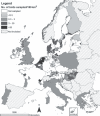Avian influenza surveillance in wild birds in the European Union in 2006
- PMID: 19453436
- PMCID: PMC4941908
- DOI: 10.1111/j.1750-2659.2008.00058.x
Avian influenza surveillance in wild birds in the European Union in 2006
Abstract
Background: Infections of wild birds with highly pathogenic avian influenza (AI) subtype H5N1 virus were reported for the first time in the European Union in 2006.
Objectives: To capture epidemiological information on H5N1 HPAI in wild bird populations through large-scale surveillance and extensive data collection.
Methods: Records were analysed at bird level to explore the epidemiology of AI with regard to species of wild birds involved, timing and location of infections as well as the applicability of different surveillance types for the detection of infections.
Results: In total, 120,706 records of birds were sent to the Community Reference Laboratory for analysis. Incidents of H5N1 HPAI in wild birds were detected in 14 EU Member States during 2006. All of these incidents occurred between February and May, with the exception of two single cases during the summer months in Germany and Spain.
Conclusions: For the detection of H5N1 HPAI virus, passive surveillance of dead or diseased birds appeared the most effective approach, whilst active surveillance offered better detection of low pathogenic avian influenza (LPAI) viruses. No carrier species for H5N1 HPAI virus could be identified and almost all birds infected with H5N1 HPAI virus were either dead or showed clinical signs. A very large number of Mallards (Anas platyrhynchos) were tested in 2006 and while a high proportion of LPAI infections were found in this species, H5N1 HPAI virus was rarely identified in these birds. Orders of species that appeared to be very clinically susceptible to H5N1 HPAI virus were swans, diving ducks, mergansers and grebes, supporting experimental evidence. Surveillance results indicate that H5N1 HPAI virus did not establish itself successfully in the EU wild bird population in 2006.
Figures




References
-
- Alexander DJ. A review of avian influenza in different bird species. Vet Microbiol 2000; 74:3–13. - PubMed
-
- FAO Technical Task Force on Avian Influenza . Potential risk of highly pathogenic avian influenza (HPAI) spreading through wild water bird migration. FAO AIDE News 2005(Special Issue);33:1–7.
-
- Chen H, Smith GJ, Zhang SY et al. Avian flu: H5N1 virus outbreak in migratory waterfowl. Nature 2005; 436:191–192. - PubMed
Publication types
MeSH terms
LinkOut - more resources
Full Text Sources
Medical

